Ron Howard MasterClass review synopsis
What you’ll learn: Learn how to direct a feature film from veteran director Ron Howard.
How long does the Ron Howard MasterClass take?: The Ron Howard MasterClass takes 7 hours and 48 minutes to complete.
Similar courses: James Cameron, Jodie Foster, Werner Herzog, Spike Lee, Martin Scorsese, Mira Nair, Hans Zimmer
Do I recommend Ron Howard’s MasterClass?: Yes, Ron Howard’s MasterClass is a tremendous look at the directing process and would benefit anyone who is interested in filmmaking on any scale.
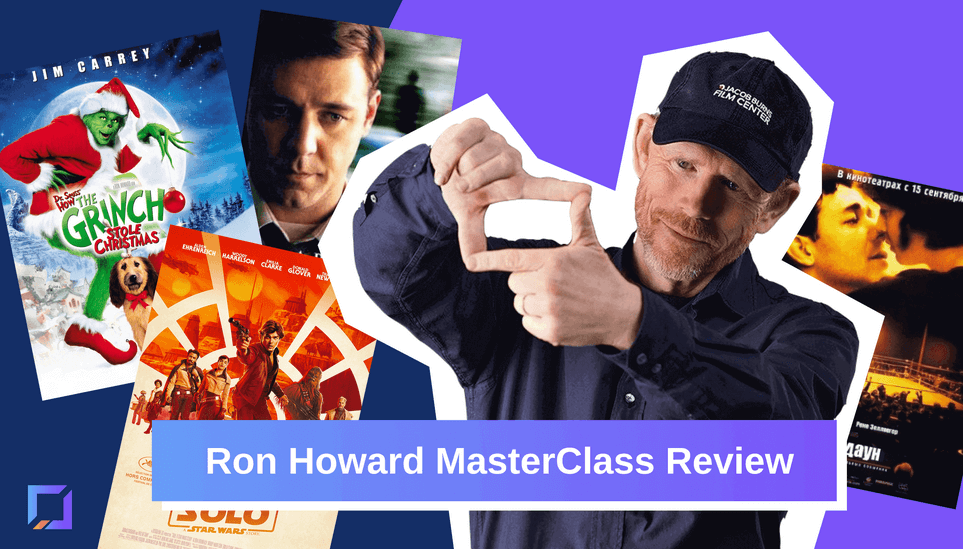
Behind every great movie, there is a visionary mind — a great director who sees their vision come from conception to fruition. As is often the case, one of the most prolific directors of our time started out as an actor.
If you’ve ever watched the classic television show Happy Days, you’ll remember the lovable red-haired protagonist, Richie Cunningham.
When the cameras weren’t rolling, and he wasn’t palling around with Potsie and the Fonz, Richie Cunningham was known as Ron Howard.
After making a name for himself as an actor, Howard became a director, bringing to life some truly classic marvels like The Davinci Code, Apollo 13, Cinderella Man, and Frost/Nixon, among many many others.
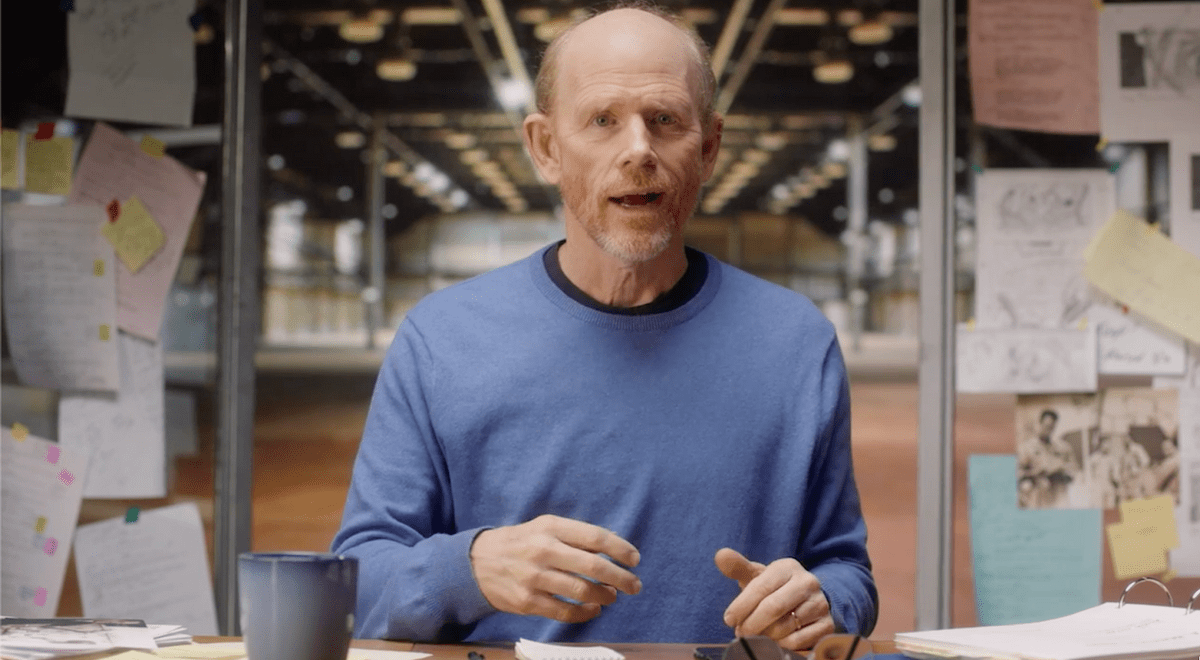
It’s true that a lot of young movie buffs dream of lighting up the silver screen as an actor, but there are also many who want to create — to be the visionary behind the next great film that lights up the Box Office.
It’s for those people that this MasterClass was made.
The Ron Howard MasterClass aims to teach you everything you need to know about directing a film, from choosing the right script to casting, collaboration, shooting, cinematography, sound design, scoring, editing, and more.
But does it accomplish this goal?
In this Ron Howard MasterClass review, we’re going to answer that question.
Disclosure: In the interest of full transparency, Codeless uses affiliate links in our MasterClass reviews to cover our site’s costs.
Our Verdict
I enthusiastically recommend this MasterClass for anyone who has considered going into the field of filmmaking.
Ron Howard’s Masterclass Become a Pro at filmmaking
PROS
- Captions are offered in Spanish and German
- Uses his movies and other people’s movies as examples
- Passionate about filmmaking
- Goes in-depth on Frost/Nixon
- Takes the time to really teach you
CONS
- Might be too long for some
- Workbook isn’t very detailed
In this MasterClass review, you’ll learn:
A few frequently-asked questions…
Let’s get started by answering a few frequently asked questions.
Do I need a subscription to access this course?
Yes, a MasterClass subscription is required to take the Ron Howard MasterClass.
How long is the MasterClass?
The Ron Howard MasterClass comprises 32 videos that will take 7 hours and 48 minutes to complete.
Does MasterClass have a cancellation policy?
All MasterClass subscriptions have a 30-day money-back guarantee.
Is the Ron Howard MasterClass worth it?
The Ron Howard MasterClass is a huge time commitment, but it is very much worth it if you’re interested in directing a film.
Get your film career started with the Ron Howard MasterClass
About Ron Howard
Ron Howard is well-known on both sides of the camera. He played the lovable Opie on The Andy Griffith Show as a child and Richie Cunningham on Happy Days as a teenager. More recently, he could be heard as the snarky narrator on the hit comedy Arrested Development.
But if you only know Howard by his on-camera work, you’re missing out. He’s one of the most prolific directors of our time, helming timeless projects like Splash, Cinderella Man, A Beautiful Mind, Apollo 13, Frost/Nixon, Rush, and many more.

Howard earned Academy Awards for Best Director and Best Picture for A Beautiful Mind.
How much does Ron Howard’s MasterClass cost?
Ron Howard’s MasterClass is a part of the general MasterClass subscription.
There are three different levels of MasterClass subscriptions.

The Standard Plan is $15 per month and is billed once a year. When subscribing to this plan, you can watch MasterClasses with one device at a time. That device could be a computer, TV, phone, or tablet. Supplementary materials like a workbook and a members-only community forum are also included.
The Plus Plan is a slight increase at $20 per month billed annually. Plus, members get everything offered on Standard, along with the ability to watch classes on two devices at the same time. You can also download videos for offline viewing on an iOS device.
Finally, there’s the Premium Plan, which costs $23 per month billed annually. With this higher tier, you’re able to get everything from the Plus Plan, with the option to watch classes on six devices simultaneously.
Choose your MasterClass subscription today
What is included in the Ron Howard MasterClass?
Runtime: 7 hours and 48 minutes
Course Value: 5/5
Lessons: 13
Supplementary materials: Workbook and access to MasterClass Hub forum
Supplementary workbook
Howard’s MasterClass workbook is a companion to the actual classes you’ll be taking. Each chapter in the book corresponds to a video that you’ll watch.
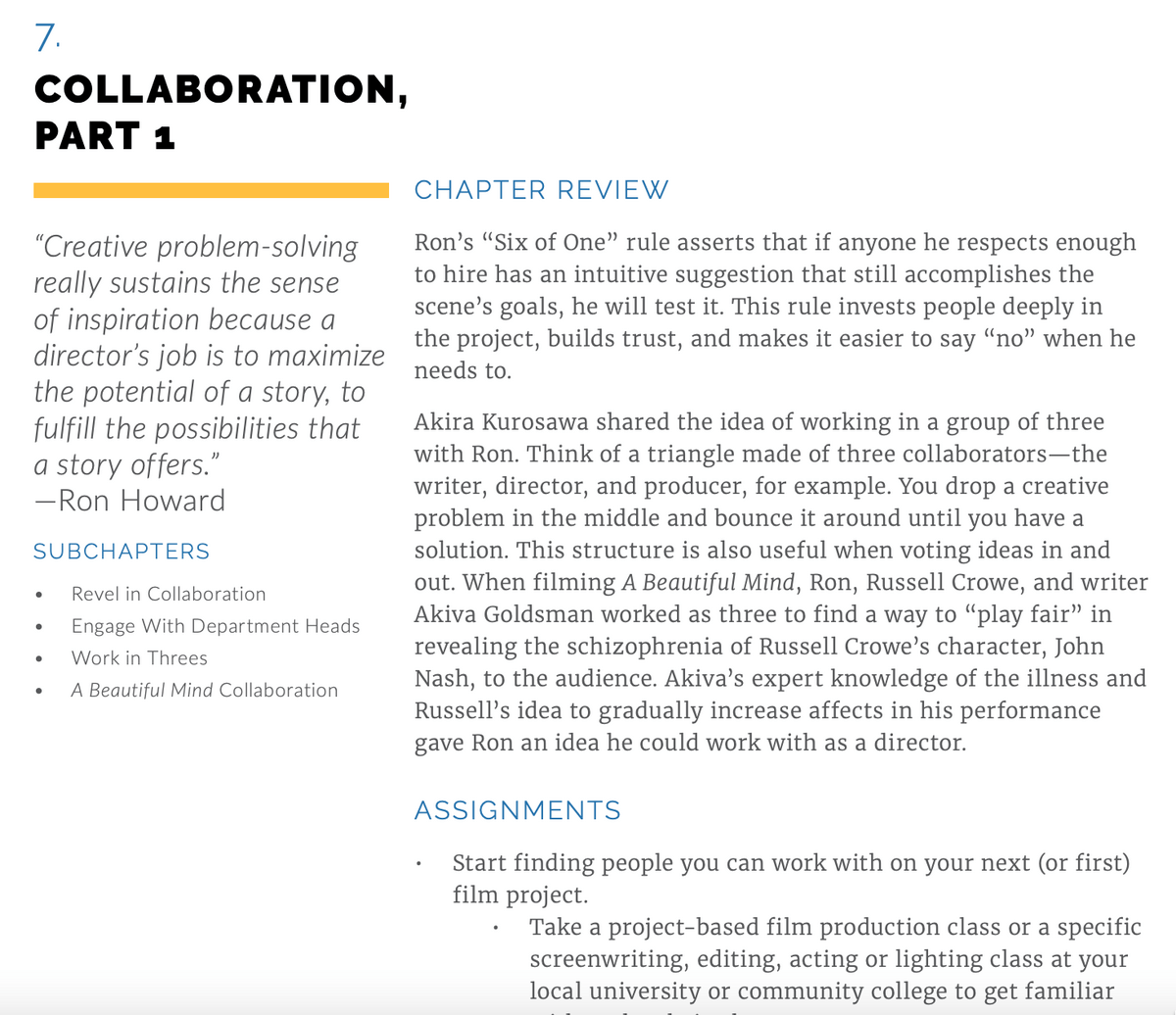
The chapters all feature a quote from Howard along with a bonus assignment that will help you get more out of the class.
As with a lot of MasterClass workbooks, there aren’t a lot of visual aids. That means this is one massive wall of text, which can be intimidating to some.
Also, I was hoping this would be more akin to the workbook for the James Cameron MasterClass, which served more like a textbook, offering a slew of definitions and diving deeper into specific filmmaking concepts. Sadly, that’s not the case.
The MasterClass Hub
All MasterClasses have a community forum that’s called the MasterClass Hub.
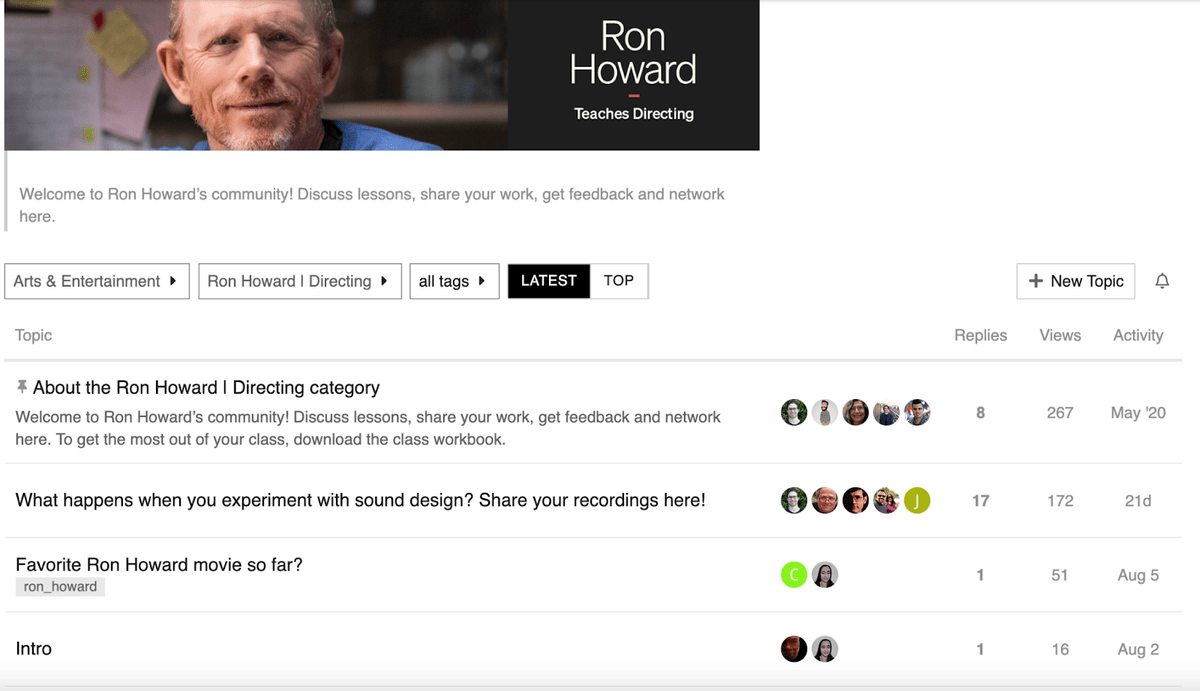
Howard’s MasterClass has a hub that seems fairly active. It isn’t the most active I’ve seen while doing these reviews, but there seemed to be some lively conversations on there, with many threads having hundreds of responses.
A complete breakdown of the Ron Howard MasterClass curriculum
This is a long MasterClass.
I mean, really. It’s long.
At almost eight hours in length, Howard covers a lot of ground. There are 32 video lessons in this class, which we’re going to list for you below.
Curriculum:
- Introduction
- Choosing a Story
- Evaluating a Script
- Refining a Script
- Story Inspiration: Case Studies
- Developing the Film
- Collaboration: Part 1
- Collaboration: Part 2
- Working with Cinematographers
- Cinematography
- Production Design
- Case Study: Frost/Nixon
- Research
- Scene Deconstruction: Raiders of the Lost Ark
- Scene Deconstruction: Apollo 13
- Scene Deconstruction: A Beautiful Mind
- Casting
- Working with Actors: Part 1
- Working with Actors: Part 2
- Frost/Nixon: Read-through & Staging Rehearsal
- Frost/Nixon: Feature Staging for Masters
- Frost/Nixon: Feature Staging for Coverage
- Frost/Nixon: Alternate Staging Possibilities
- Frost/Nixon Steadicam Staging
- Frost/Nixon Steadicam Staging for Frost POV
- Frost/Nixon: Staging for Indie Shoot
- Frost/Nixon: Staging Review
- Editing: Part 1
- Editing: Part 2
- Sound Design
- Music and Scoring
- Find a Story You Love
Course summary:
Occasionally you encounter a MasterClass where it seems like the instructor really doesn’t care and doesn’t want to be there (like deadmau5, for example).
You never get that sense from Ron Howard.
From the word go, he leaps into instruction with a passion that rivals Neil Gaiman and a knowledge of film that rivals Neil deGrasse Tyson’s knowledge of the cosmos.
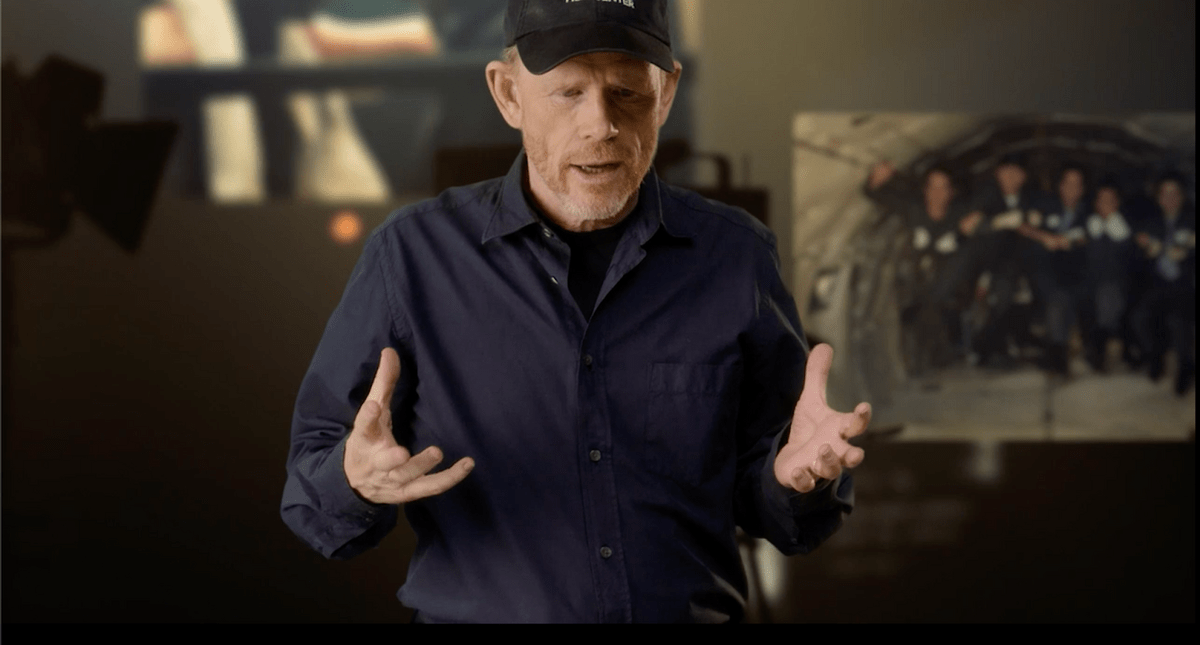
This is a detailed course, to say the least. Howard instructs you for nearly eight full hours.
To compare, the Bob Iger MasterClass is just over two hours. While I feel it could have been longer, its length is more in line with what I’ve seen from others.
So, right away, Ron Howard is giving you more for your money. But is it just eight hours of blathering that could have been summed up in two?
Absolutely not.
Howard takes you on the full directorial ride. He starts at the beginning, walking you through how he selects scripts to work on. He teaches you how to evaluate a script and create your own quality checklist.
He then goes into detail on film development and the collaboration you have to go through with actors, crew members, studio executives, cinematographers, etc.
When he starts breaking down actual scenes, it gets really interesting because you can see the film in the way that a true artist sees it. What I found really interesting was that the first scene he broke down wasn’t from one of his movies.
It was from Steven Spielberg’s Raiders of the Lost Ark.
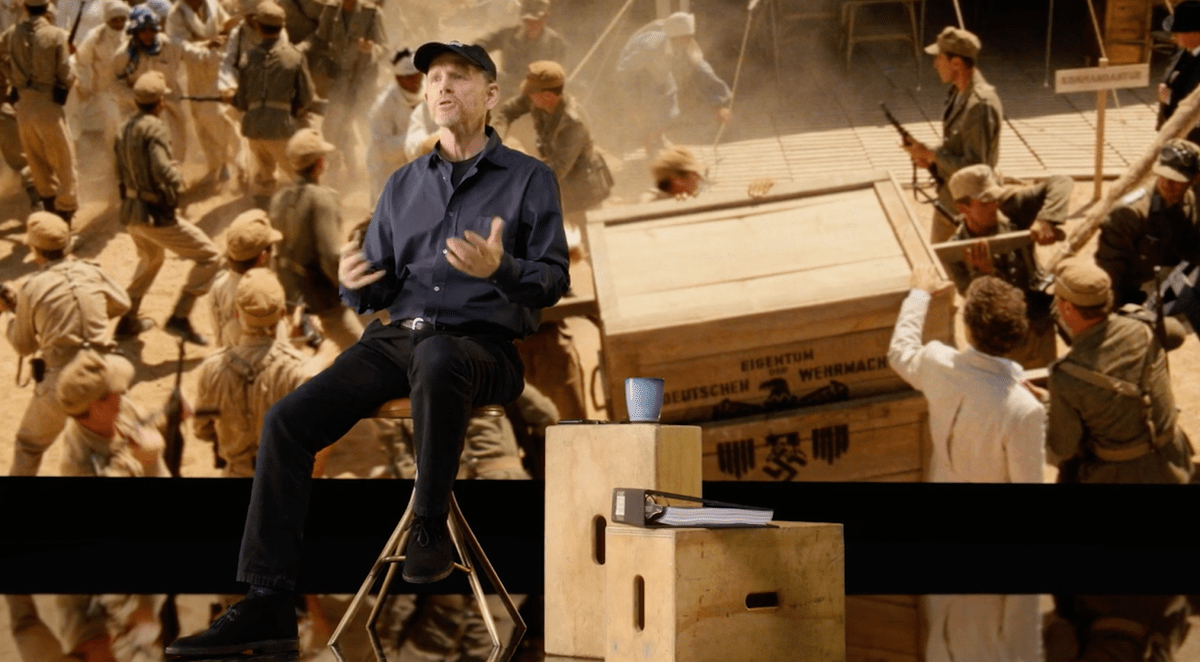
He then goes on to show scenes from Apollo 13 and A Beautiful Mind, but he breaks them all down without any sound, wanting the student to really dive into the moment and appreciate the directorial choices both he and Spielberg made.
Howard moves on to the casting process next, which can make or break a film. There are two whole lessons on working with your actors to get the best out of them. He also teaches you how to listen to their ideas to improve upon the film.

He then goes into a long breakdown of examples from Frost/Nixon, which is great for learning while watching someone do what they’re famous for.
Finally, he takes you through the editing process, including sound engineering and scoring.
All in all, it’s a massive and epic eight-hour journey that is the true definition of a MasterClass.
What I learned
To me, the name Ron Howard stamped on a project has always meant quality (except for that Jim Carrey Grinch fiasco, but we all make mistakes).
I’ve always wanted to write and direct a film, and Ron Howard is a personal hero. That’s why I was so psyched to take and review this MasterClass, especially when I saw that it was nearly eight hours long.
Howard explains a lot and shows you what can’t be explained.
He’s an amazing teacher who genuinely seems to want to educate the next generation of filmmakers. I learned a lot about the directorial process, which I’ll go into in this next section.
16 takeaways from this MasterClass
Here are my top 16 takeaways from the Ron Howard MasterClass (Yes, it’s a lot, but it’s a super long course):
1. Freshness is important when choosing a story:
The execution can be hugely outstanding, but if it’s not a fresh take either from the setting or a cinematic approach, it’s going to be downgraded in the minds of your audience. The first Star Wars was a collection of old myths that were retold in a new and exciting way.
2. Trust your instincts:
We all have our own instincts, and that’s a good thing. We have to hone and trust in that and back it up with our craft.
3. You have to evaluate scripts to determine if the project is right for you:
Howard has a checklist that allows him to rate the key components of a script, outlining the strengths and weaknesses of the screenplay.
He starts by analyzing the genre and rating on a scale of 1 to 10 how well it achieves the promise of that genre. He then looks at whether the characters are interesting along with the structure of the story.
4. He believes less in a three-act structure and more in sequences:
Instead of looking at storytelling in terms of the traditional three-act structure, he sees sequences of 8 to 12 pages. That comes out to about 10 minutes of screentime each. It’s like chapters in a story. The sequences each have their own beginning, middle, and end.
5. You have to apply scrutiny to a screenplay:
The director needs to understand and support the screenplay. To get to that point, you have to apply scrutiny. Read through it with the screenwriter and actors, or even friends. Ask questions and get feedback afterward.
Then the director has to get involved in the rewrites. Have conversations between the writer, director, producers, and actors to make sure the story is where it needs to be before filming.
6. Development Hell is aptly named:
This stage involves a lot of back and forth, and it can take literal years before someone is willing to commit resources toward a project.
A screenplay is a blueprint for a movie, and you have to find people willing to build that building. Development Hell tests a director’s belief because people are going to pull the idea apart.
7. Sometimes, ideas that feel like compromises end up benefiting the project:
Compromises free up money, which can help you improve on another sequence with the extra budget. They also help you look at things in a new way. Sometimes that new way is better.
8. Revel in collaboration:
Directors are the keepers of the story, but if an actor comes up with a suggestion that they understand on an organic level, you should let them use it — if it still accomplishes your goals. It develops respect and trust with collaborators.
9. He doesn’t have a signature style:
Instead of imposing his own style upon a movie, Howard lets the movie speak to him and show him how it wants to be shot.
This flies in the face of directors like Tim Burton or Zac Snyder, who often impose their signatures on a film whether it’s called for or not (He didn’t make that comparison. I did. I hate those two. That’s right, I said it).
10. Light and lenses make major differences:
You have to mix light and lenses in order to create the shot you need at that moment. Light can be its own character and really set the scene.
Different lenses convey different feelings and can generate specific emotions in people. You need to be free with lenses and experiment with them. He had success with this in Frost/Nixon.
11. You need to look for creative compatibility with actors when casting:
The actor, the character, and your sensibility will create a strong foundation for the movie to be built on. And if an actor disagrees with your approach, don’t dismiss it.
Ask yourself whether they’re right and you’re wrong. If there’s a disconnect, you’re not going to benefit the story you’re trying to tell by talking them out of their ideas.
12. Your ensemble might have different styles, and you have to work with them:
You can’t be oblivious to how different actors work. Some might be more improvisational, while others want marks and to stick to what’s written. Some actors might want more takes, and some might want fewer. You can find ways to respect all of these various takes in one ensemble.
13. Your stylistic choices inform performances:
For example, the actors can use their bodies more, like in a theatrical performance, if you’re shooting wide. If you choose to shoot in a restrictive way, you have to help them adapt.
14. Editing is the final rewrite:
There’s a lot of creativity that still has to happen after you gather all of your “raw materials.” Editing is where you come to terms with the actual possibilities of your story. The editing room is where your story is going to tell you what it has to say.
15. In editing, you need to continue to understand the themes of your film that you initially perceived, but not cling to them:
You have to be honest about what the film succeeds in saying, what it doesn’t, and what it possibly could say.
16. The first cut will break your heart:
No one has ever had their first cut called a genius masterpiece. They’re typically very long, and there are fundamental weaknesses there that can be addressed editorially. That despair has to be overcome if you’re going to produce the best film possible.
See what you can discover about filmmaking in the Ron Howard MasterClass
Memorable quotes from this MasterClass
“Those things that you sometimes fear actually can wind up being the forces that push you to a higher creative plane.”
– Introduction
“We’re all storytellers. It makes us believe we can all direct. And we probably all can!”
– Choosing a Story
“Every project you get involved in, ultimately, is just going to find its way to breaking your heart at some point.”
– Developing the Film
“I revel in the excitement of collaboration. I think it provides all of us — not just me — with a kind of creative safety net.”
– Collaboration: Part 1
“Whenever possible, I really prefer to build on what the actors’ instinct naturally is.”
– Working With Actors: Part 2
“The best films benefit from this single oversight.”
– Editing: Part 1
“Editing is a very personal thing on the one hand, but it’s also a period where some objectivity from outsiders can really benefit you.”
– Editing: Part 2
Ron Howard Masterclass pros and cons
As with all things, there were some good and bad aspects of Ron’s MasterClass. Let’s explore all of the pros and cons so that you can make a more informed decision.
Pros
There was so, so much that I loved in this MasterClass. Here’s a list of some of the pros I encountered:
- Captions are offered in Spanish and German
- Uses his movies and other people’s movies as examples
- Passionate about filmmaking
- Goes in-depth on Frost/Nixon
- Takes the time to really teach you
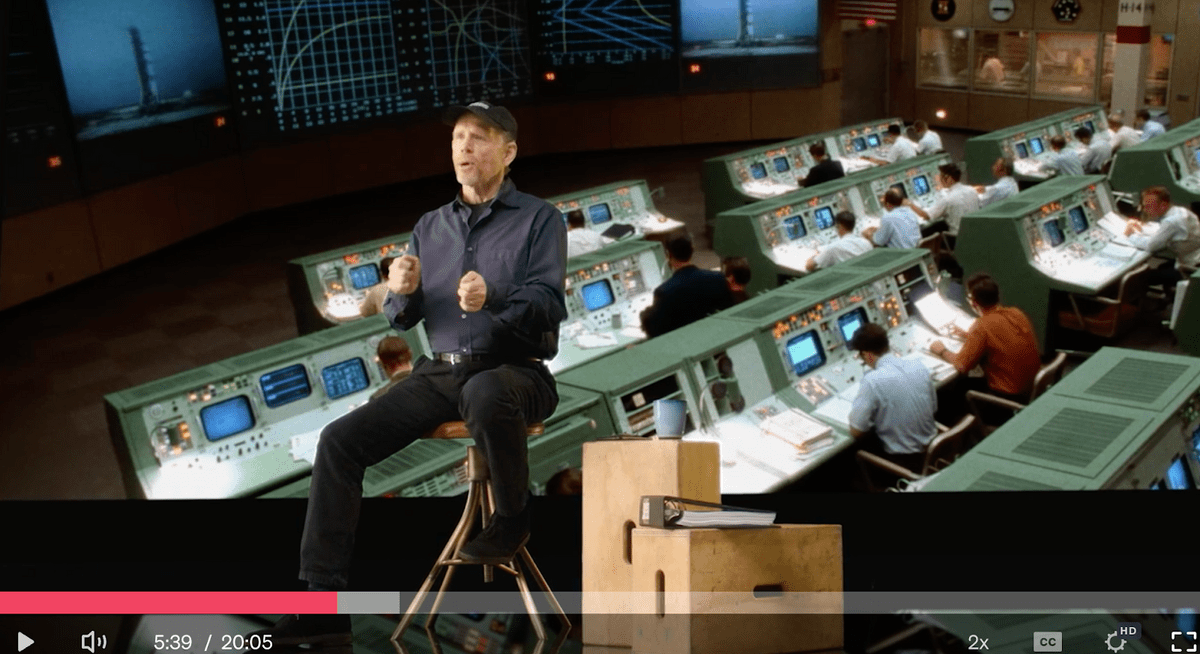
Cons
That’s not to say that Howard’s MasterClass was flawless. Here are a few cons to consider:
- Might be too long for some
- Workbook isn’t very detailed
Do I recommend this MasterClass?
I enthusiastically recommend this MasterClass for anyone who has considered going into the field of filmmaking.
It’s long and involved, but that’s not a bad thing. You can really get a full understanding of the topic with Howard’s careful and considerate advice.
This was a 10/10 for me. Go do it.



